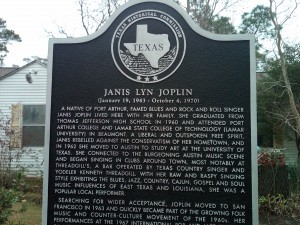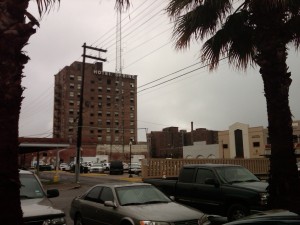
If Janis Joplin hadn’t succumbed to that fatal dose of heroin in 1970, today she might have been celebrating her 68th birthday.
I’ve been thinking a lot about her since a recent trip to Los Angeles, where I had the privilege of reading four letters she wrote to her family in the late 1960s and early 1970, part of an excellent exhibit at The Grammy Museum. “Mother and Dad,†she begins in one from San Franciso, “Right now my position is ambivalent. I’m glad I came, nice to see the city, a few friends, but I’m not at all sold on the idea of becoming the poor man’s Cher.â€
I decided that when I returned home, I would visit Joplin’s home-town in Port Arthur. It seemed appropriate, as well, to visit on Martin Luther King Day. Why? Because, even as a teenager, Janis was outspoken on racial integration, and this seemed a significant aspect of her character. One of the many things that caused her to flee the Gulf Coast for Austin and then San Francisco was the nickname she’d received from her thoughtful high-school classmates: “nigger lover.â€
As her friends explain in the documentary film Southern Disomfort, that nickname expanded to include the terms “pig†and “whore.†When Joplin had lived there in the 1950s, the city had been deeply segregated. I was hoping to find it changed, at least since Janis’ notorious press conference there in the summer of 1970.Click here to watch the press conference in Port Arthur.
Part of the display at The Grammy Museum featured Joplin’s own reminiscence of Port Arthur: “I was a misfit. I read, I painted…†But the display did not include the remainder of that famous quote, which was documented (according to web sources) in 1984 by writer Laurie Jacobsen: “…I didn’t hate niggers.†I can understand why The Grammy Museum considered that phrase upsetting for many visitors. However, I don’t feel I should delete it here for adult readers who can comprehend the irony.
On Monday morning, I left Houston and headed southeast towards Port Arthur, which is only about 80 miles away, really a stone’s throw by Texas standards. I’d been there once before, during a cross-country bicycle tour. All I could remember was a horrifying stretch of oil refineries and their bad smells, and then cycling over the dramatic Dr. Martin Luther King, Jr. Memorial Bridge to a place called Pleasure Island, gateway to Louisiana.
Now in the comfort of my car, I listened with admiration to recordings of King’s great speeches and sermons on public radio, thought about my childhood experience of integration (having grown up outside of Hartford, Connecticut), and passed through Texan places with names like Gator Junction and Turtle Bayou. The latter, in particular, reminded me of one of Janis’ earliest compositions, Turtle Blues:
“I guess I’m just like a turtle, that’s hidin’ underneath its hardened shell. But you know I’m very well protected, I know this goddamn life too well.â€
Arriving in Port Arthur, I looked for Museum of the Gulf Coast on Procter Street, which promised a permanent exhibit devoted to Joplin. The museum’s curators had also arranged to provide a special screening of Southern Discomfort. I had downloaded their map for the road trip of important Janis Joplin locations as well: St. Mary’s Hospital, where she was born; her childhood homes, the Texaco Refinery where her father worked, her schools, even the church where she was baptized. At the bottom of the brochure is a slogan from Port Arthur Convention & Visitors Bureau, “Port Arthur-Where Oil and Water Do Mix. Beautifully.†Oh, dear.
Stopping at a grocery store to buy soft drinks and antacid, I couldn’t help but notice the local daily at the cash register. The front page of Port Arthur’s The News featured the headline, “King’s Dream Alive in PA.†Curious, I added the newspaper to my purchases.
Later, at lunch, I discover that it’s one of those vaguely uplifting stories tinged with a sense of propaganda. Retired teacher Virginia Ervin, the first black teacher at Sam Houston Elementary, shares her thoughts on integrating Port Arthur’s schools in the early 1970s. If you read between the lines, however, her testimony is ambivalent. Ervin says that “Dr. King’s dream is still alive,†and cites accomplishments at Memorial High School and Port Arthur Independent. At the conclusion, she says, “Schools have integrated, with the latest major integration of the high schools.†Latest major integration? Is she serious? Isn’t this the 21st century?
Back to museum, however. It’s a pristine building in the middle of what looks like a bombed out street, with nothing for 20 blocks or so but abandoned buildings. Many of them appear to have suffered fire or hurricane damage. There are no pedestrians. The Hotel Sabine, Port Arthur’s tallest structure, is more than just an eyesore. The city has been trying to sell it for several years, but there are no takers. The windows are smashed.

I am shocked and drive slowly, taking pictures with my mobile since nobody is around to complain about it. I try to imagine what “downtown†must have been like to Janis the child or teenager: a variety of restaurants and clubs, shopping outlets, barber shops and newsstands. In 2011 it is a ghost-town in the worst way imaginable. Even the ghosts have departed.

The display on the second floor of Museum of the Gulf Coast devoted to my childhood Rock-Star-Diva-Idol turns out to be disappointing, with a few paintings by Janis (two portraits and others on religious themes), a replica of her legendary psychedelic convertible Porsche, and a glass display case with predictable mementos. Her 1958 yearbook is there, indicating that she belonged to Art Club and Slide Rule Club, along with some nice photos and a few hand-written items. But it’s far less than what I saw at The Grammy Museum.
Nearby is an entire gallery devoted to another famous Port Arthur artist, Robert Rauschenberg. He graduated from high school there in 1943, the same year Janis was born. His 1970 Signs includes a towering image of Janis at the microphone, with a silk-screened photo of Martin Luther King, Jr. laid out in a coffin below. Well, at least Rauschenberg “got it.â€
The museum gift shop features a tragic collection of bad Janis T-shirts, a few of her CDs, prints and postcards, and $25.00 bricks from her childhood home (now demolished) with a rubber stamp of authenticity. I think about buying one, and then remember those episodes of Hoarders on television and decide against it. Lavern, the cheerful retiree at the cash register, explains that they can only sell what is authorized by Janis’ brother, and that “he’s not very responsive.†He doesn’t live in Port Arthur any more.

It is early afternoon as I drive by the Edison Middle School on 12th Street, which used to be Thomas Jefferson High School, where Janis attended grades 10-11. Since it is Martin Luther King Day, however, the school is closed and empty and I can’t observe students milling around after school. Back in Houston, my friend from Port Arthur told me that the town, which has approximately 60,000 inhabitants, is hardly integrated. For the most part, she says, blacks live west of the train tracks and whites to the east. All of the decent shopping is at a mall in Nederland, white territory, and drug use and prostitution are rampant in the declined area surrounding downtown, which is without doubt the worst place I’ve seen in America.
The rest of the Port Arthur News isn’t filled with many inspiring stories. Just below the cover feature on Ervin is another headline: “Eleven houses slated for CODE enforcement in Groves.†The next city north and bordered on three sides by Port Arthur, the story describes houses there to be demolished “if the owners don’t have them repaired quickly.†The acronym stands for the Council on Dangerous/Empty Structures. Since it began in 2004, the program has torn down 150 structures in the area. The story finishes with news of the City Council approving an ordinance setting curfew hours for minors.

There’s a plaque from the Texas Historical Commission in front of Janis’ childhood home. In front of the house is a chipped concrete donkey. “How Janis would cackle about this,†I think to myself, imagining how we would smoke cigarettes together and pass a bottle of Southern Comfort back and forth as we strolled away irreverently. It’s one of those momentary, strange daydream-fantasies. After a brief spur to Pleasure Island, mainly to view the smoking oil refineries from above, I head back to Houston. Â
In the 1960s, while some gay boys looked to Maria Callas, Diana Ross, Judy Garland, Cher or others for solace, I made Janis Joplin my first and foremost diva. Nobody has ever taken her special place in my mind. I received the record Cheap Thrills from my grandmother as a gift for my 10th birthday. At that time I considered it the most significant musical event of my childhood. I had no idea then that by the end of the year, Janis and Big Brother and The Holding Company would sell a million copies.
Of course, the stories of Joplin’s lonely childhood in Port Arthur established the idea, even to a child’s sensibility, of Texas as a place one should flee. I was won over by this concept, since I felt that same desperation to escape Connecticut, imagined it constantly and set the aspiration to make it happen once I enjoyed the mobility of an adult. Looking back, I think this horrible environment and racially divided town, Port Arthur, had also caused her imagination to flourish. It’s a cruel, bitter paradox.
Recently I was listening to one of my favorite composers, Robert Ashley, who made a strange composition rooted in a text by John Barton Wolgamot, titled In Sara, Mencken, Christ and Beethoven There Were Men and Women. The CD liner notes include this quote on Wolgamot from Ashley:
“But he lived and worked during a time and in a place where such a commitment was the only possible expression of his genius. All over America, before we became homogenized by the media (and by the ability to travel!), people lived in loneliness and dreams. This was a new people. And especially in the vast (endless) Midwest, where the European-Americans were cut off from their roots, a “civilization” – that is, a collection of memories that make sense of the present – had to be invented.”
The quote seems so apt when considering Janis. Committed and passionate, she might not have invented the blues but she certainly reinvented them and brought them to mainstream America. She hated that Dick Cavett called her “a star,†reminding him that she was rather “a singer.†She never identified as a hippie, preferring to call herself a beatnik.
Writing to her family on January 23, 1970, she revealed her ongoing struggle with fame. It’s a communiqué that breaks my heart: “I’ve been looking around and I’ve noticed something. After you reach a certain level of talent (quite a few have that talent) the deciding factor is ambition, or as I see it, how much you really need. Need to be loved & need to be proud of yourself… Maybe it’s for love. Lots of love! Ha…â€
Happy Birthday, Janis.



This is a fabulous article on Janis Joplin and her bravery in fighting racism in her own town. Reading Mr. Bale’s article, I find myself feeling her struggle with trying to become an adult in Port Arthur and then seeing what her possibilities were outside of her home town. Janis’ music still carries a lot of power in today’s world. She was a strong woman, who felt the world’s tears in her music. We need more people like Janis to continue to create songs and sing about the issues regarding racism, sexism and conformity that face so many people today.
I’ve made the trek as well. I enjoyed your views of Port Arthur, Janis and so I thought I’d send you the photos I took. http://www.flickr.com/photos/jillsmooch/sets/72157625908602897/with/5439236359/
Jill, these photos are stunning! I encourage interested readers to view the flickr link to see more of Port Arthur. Thanks so much for sharing these images!
You “passed” thru Port Arthur. You did not “see” Port Arthur. Yes, the old “down town” is not pretty. But we have a new Mall, new fire depts, scads of restaurants. Wonderful people. You judged us way to sharply. You should have visited the real Port Arthur, and talked to the citizens. There is so much more to Port Arthur than Janice Joplin.We have so many more people that were not dope heads that are true amabassadors for Port Arthur. Sports heros, Musicians and other entertainers listsed in the Who’s Who. If you had taken the time to go to the Museum of the Gulf Coast and the Texas Artists Museum you would have seen that Port Arthur is loaded with great people. As far as your so called segregation thing, we have no segregation, i.e. we have a black mayon, many black councilmen and school board0members. So you have no suport for the segregation thing. Come back and see the REAL Port Arthur.
Dear Ms. Crenshaw, thanks for reading my column and for sharing your perspective. Ms. Joplin’s first name is spelled “Janis.” If you read more closely, you’ll see that I did, in fact, attend the Museum of the Gulf Coast. My comments about segregation there came mostly from a conversation with a young African-American friend who grew up in Port Arthur. Your characterization of Ms. Joplin as a “dope head” is more evidence that certain people of Port Arthur still disrepect this great artist, even 40 years after her death.
Thanks for your very well-written, well-researched article. I fell in love with Turtle Blues from the beginning. I understand what Ms. Crenshaw is saying. She has a right to be proud of much of her city but, Mr. Bale, if I hear you correctly, you are saying that what they have accomplished has been with a steep price. It sounds like the city is trying to sweep much of its history under the rug. It needs to own what it once was and admit that it was not pretty. The decay, the slums, the defacto segregation, the rebellion of this very, very talented young woman who had to seek development of her talent elsewhere because she didn’t accept the segregationism of her time in her hometown, these are things Ms. Crenshaw needs to own. Again, thank you, sir, for this excellent article.
Thanks so much for the information. I’ve now bookmarked your site in my favorites for the future! Thanks again.
Think Mary Karr’s “The Liar’s Club” or “Cherry.” She lived PA and got out of dodge!
Great article, myself a very young teen of San Antonio in ’69 I wish I could have experienced the whole hippie era. If Janis were alive and well today, she’d probably say she wasn’t surprised at all of Port Arthur and it’s residents. There are cities that made use and upgraded old buildings. What a waste of old landmarks. Goes to show they’re stuck in their old ways. Seems their residents with creative minds and free spirited just up and left for good reasons.
With all due respect, Mr. Bale, I believe there are a few facts you have either misinterpreted or overlooked. Unless the context of the article indicates differently, the “integration” Mrs. Ervin was referring to in the high schools was likely not racial integration as you believe. I think she was referring to the merger of Port Arthur’s three high schools: Thomas Jefferson, Abraham Lincoln and Stephen F. Austin. Although TJ and SFA were the traditionally white schools and Lincoln the traditionally black school, they had been racially integrated for a long time (I believe the integration of the entire district occurred in 1972; it was definitely in that neighborhood) before they were merged into Port Arthur Memorial in 2001. I may be wrong because it has been some time since then, but I believe all three schools were predominantly black at the time of the merger; Memorial still is today, albeit by a shrinking margin.
Also, I don’t know what Port Arthur native you are acquainted with, but I do not believe he or she has been to Port Arthur in quite some time. You say you were told that Port Arthur’s black neighborhoods are located on one side of the tracks and Port Arthur’s white neighborhoods are located on the other. That has not been the case since the pre-integration days. In fact, as a fourth generation native of the Golden Triangle area who grew up just outside of Port Arthur (“white territory,” as you refer to it; for the record, I am not fully white) with quite a bit of family still in Port Arthur, simply put, Port Arthur has no white neighborhoods. There are many whites who live in Port Arthur (36.1% of the city is white, according to the latest census data), but the idea that they live in neighborhoods all to themselves is, for the most part, outdated. In fact, I can only think of one neighborhood located within the Port Arthur city limits that might be mostly white. Many are mixed to some degree with the rest being either almost entirely black or Hispanic.
On that note, it should be said that the racial divide you seem to believe exists in Southeast Texas is not as entrenched in the minds of Southeast Texans as it was in the days of Ms. Joplin. That’s not to say that you won’t find neighborhoods entirely dominated by one race in the greater Golden Triangle (meaning the entire tri-county area, not just Port Arthur or the “white territory” of Nederland, Port Neches and Groves), but it is to say that you won’t find a definitive boundary that starkly contrasts those neighborhoods (i.e., the railroad tracks). And that’s not uncommon in the South. I read here that you’re a columnist living in Houston. I’m sure you notice that Houston, like many other major cities and fairly populated areas, has neighborhoods predominantly occupied by one race (Sunnyside, for instance) that are buffered against each other with mixed neighborhoods, rather than outlined by a distinct physical feature. It is no different in the Golden Triangle.
I notice that you included a picture of Edison Middle School, where Ms. Joplin attended her sophomore and junior years of high school while it was still serving as the TJ campus. Based on her birth date, I assume she attended her senior year at what was then the new TJ campus. I don’t know if you were able to find that or not, but if you would like to see it, it’s located on Stadium Road (it may appear on a GPS as Highway 347 or Twin City Highway) not terribly far from downtown Port Arthur. When TJ, Lincoln and SFA were consolidated, the TJ campus served Memorial’s upperclassmen. When the new Memorial campus was eventually built a few years ago, the building was repurposed and is today Thomas Jefferson Middle School. You can’t miss it; as the name of the road may suggest, it is located directly adjacent to the stadium.
I am forced to agree with an earlier comment in that it appears that you simply passed through Port Arthur, took a look at some landmarks, captured some photos, formed an opinion and moved on. I am glad that you stopped at the Museum of the Gulf Coast; I think you’re correct in saying that it is now, unfortunately, the lone bright spot in a derelict downtown area. I hope that, while you were there, you took the time to look at some of the other exhibits in the building outside of the one dedicated to Ms. Joplin. If you did, or if you ever decide to go and see them at some point in the future, I hope you’ll realize that although Port Arthur’s past is certainly not problem-free and definitely has its troubles, it is, for the most part, something to be proud of. I know it’s hard to believe based on the condition of the city today, but there was a time when Port Arthur was a place of opportunity, and there are many distinguished natives of Port Arthur – black and white. I’m sorry that Ms. Joplin had to seek her place in life elsewhere and that you only saw one side of the Golden Triangle, but do not let yourself believe that the Port Arthur of yesterday is the Port Arthur of today or that what you saw during your visit to the area or read in Ms. Joplin’s writings tells you everything there is to know about us.
Janis Joplin was a martyr. Her artistry, so huge, could not be contained by Port Arthur and Port Arthur pushed her out to a world at large that acknowledged and loved her genius. A visionary at a very young age, she saw through and past the racism and social hypocrisy of the time and place in which she lived. Her spirit, bright and pure, manifested some of the most glorious music, vibrating with raw truth, channelled through her vulnerability and innate sorrow at both the witnessed and personal inhumanity she had been exposed to and could not put behind her. Her voice, infused with that sorrow that eventually consumed her, offered understanding and compassion to many who were negotiating the changing times, myself included. I am so grateful to her for her intelligence, sweetness and courage. The apology that Andrew above makes is disingenuous. He’s not sorry that Janis had to seek her place outside of Port Arthur; he’s angry that she shone light on it’s true nature. Not surprising that he cannot acknowledge that Ms. Joplin is in an elite league of ground breaking artists who will be enjoyed and remembered for a very, very long, long time.
Ms. Riel:
To say that I am angry would be disingenuous in and of itself. As I stated in my original post, I am happy Mr. Bale took the time to visit Port Arthur and particularly pleased that he visited the Museum of the Gulf Coast, even if I believe his opinions to be premature and ill-informed. I have no issues with Ms. Joplin or her work; I will admit that I have never been much of a fan of her music or the particular genre, but as I’m sure someone with the artistic expertise you have would admit, art is largely subjective, and the appreciation for an individual artist or her work varies according to ones tastes.
I am glad you enjoy the work of a Port Arthur native, and I hope you continue to do so in the future. I am truly sorry that she had to seek her place in life elsewhere, and the demise she met while doing so is a tragic and unfortunate one. All I ask is that while you contemplate the environment Ms. Joplin was raised in, you remain mindful of the fact that a perspective provided by an artist who has been dead now for more than four decades may be a little outdated, and that an opinion authored by a columnist who only spent a few hours capturing pictures in the area on which he opines – one who obviously made no serious attempt at researching his subject – may not be a very holistic or well-informed one.